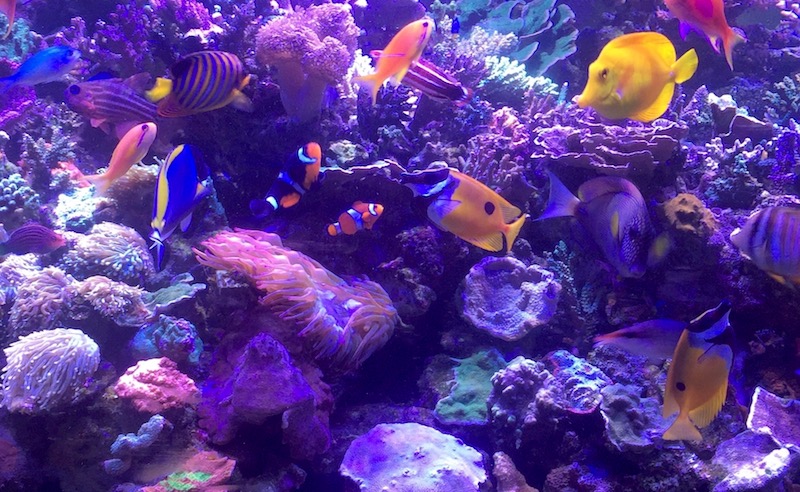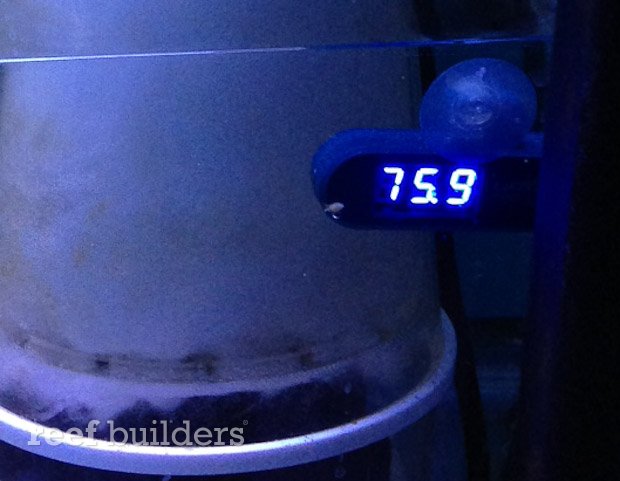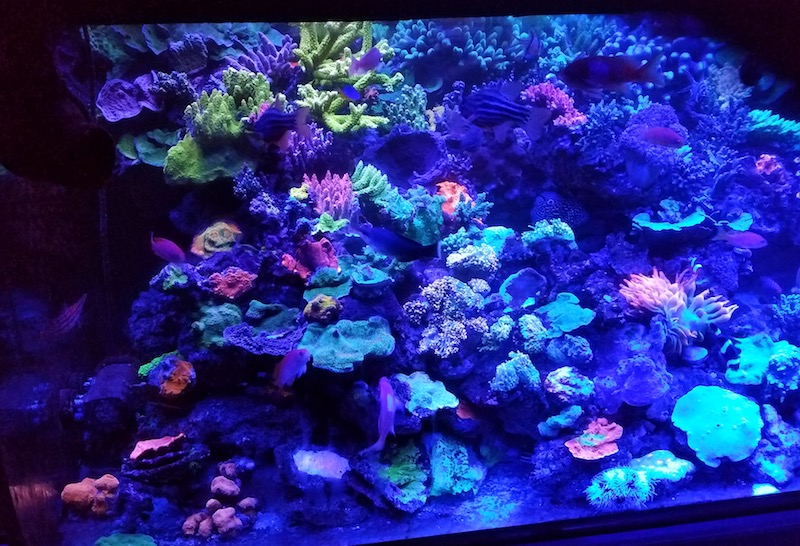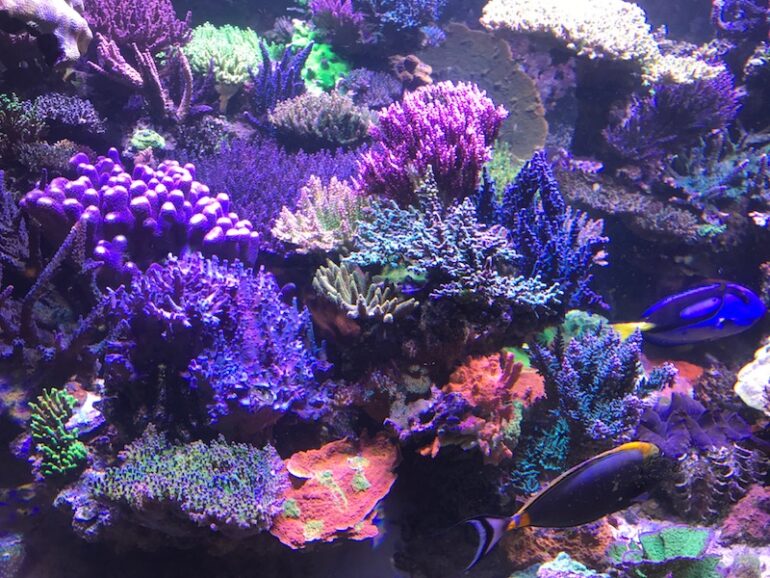As I have discussed numerous times in these articles, this is a hobby of patience. That is, we need to be patient and wait for things to occur in order to be successful such as waiting frags to grow into colonies, or tanks to cycle so we can fill them or new fish and corals to be properly properly quarantined and acclimated.
However, I have also come to realize that in a number of instances we also need to seize the moment. To paraphrase Mark Twain; we do not regret many of the things we have done, we mainly regret the things we haven’t done. Now I am not advocating that we change our approach to things and not be patient, but rather I hope to point out when we need to seize the moment and do things when the situation dictates that action is required.

The first of these may seem obvious and simple, but at least for me it is one of the things I no longer wait on. Most of us that have done this for a while, so we think we can look at our tanks and know when things are good. Conversely, when things are starting to go downhill, even a little bit we can tell.
Unfortunately, at least for me, I often do not do anything and simply wait, and often hope, that things will turn around without any intervention on my part. Sadly, it has taken me most of my time in the hobby to realize that this strategy rarely works. In talking with my friends in the hobby, they also often take this wait and see approach.
After much heartache and discussion, we all realize that this is not a good way to keep really bad things from happening. For me at least, I have finally realized that when I see something that makes me think something is wrong in the tank, even if it is small, I need to seize the moment and act. So now when I see this starting to happen I no longer wait for it to become a big problem, but I try to nip it in the bud.

First, I try to determine exactly what I am seeing that makes me think something is wrong. Then I start testing as many things as I can and if I do not see anything in these tests I send out a Triton test, even if it is not on the usual schedule. While waiting for the test results to come back I do a water change or several, and change the carbon and other media.
Some of these steps may seem a bit extreme, but now due to past mishaps I try to reduce the likelihood of small problems turning into big ones.Here are some examples of some of the seemingly small things that occurred that were not immediately really obvious, but which made me think that something bad was starting to occur.
The first occurred when my usually colorful corals started to brown out. Testing did not show anything nor did ICP testing and water changes and carbon did not slow this down. It was during the change in seasons in the Fall, and I had plugged in the heaters that had been off all summer.

When looking at the controller I was using it showed that the temperature was stable and in the range I wanted. However, when I put my hand in the tank early one evening the water felt a bit warm. When I checked it a another thermometer it showed that the tank was 3 degrees above where I wanted it to be and what the controller was showing.
Now a rise of three degrees should not have been much of a problem, but when I looked at the record on the monitor it showed that for some reason every day the heaters and the controller they were on were heating the water up 3 degrees during a two-hour period every day, but that the controller showed these numbers to be three degrees below where they actually were.
This rapid rise in temperature to a higher than desired temperature along with this swing were causing the corals to brown out. So luckily before I had a tank full of brown corals, I seized the moment and found out the cause of the problem.

In another case, a section of my tank, and only a section, looked stressed and not how it usually looked, while the rest of the tank was fine. I checked the flow around this area, looked for pests or something else that was causing the problem and could not come up with a reason.
When something like this occurs one of the things I do is to check the tank in the middle of the night. I do this as I have found this is the best time to find pests that you otherwise would not see. So I set my alarm and came down to look at the tank at 3am. To my surprise when I came down the tank was illuminated, but only the lights above this section of the tank were coming on in the middle of the night and shutting off before I came down in the morning.
So this almost constant light was stressing out the section of the tank where this was occurring. So I fixed the program and adjusted this light and within a month the corals were back to looking how they should.

The last problem that showed up as just a look, was again when the tank just had this look like something was a bit off. Again I did the testing, checked at night and could not come up with the cause. The tank was not failing, it just was losing its vibrancy. Fortunately, it was easy to find, as whenever I put my hand in the tank, I felt a slight tingle in any small cuts I had on my hands or fingers.
I always wear some kind of insulation on my feet when I work on my tanks and have GFIs to reduce the likelihood of being shocked or electrocuted, but I knew from experience that this tingling meant something electrical in the tank was bad. So my next step was to unplug every device individually while having an amp meter in the tank.
This is much better than just seeing when I was no longer felling the tingling and much safer too. To my consternation after taking a few devices off line I found that on one powerhead the electric line to it had completely corroded so all the current was going directly into the tank. Needless to say I will not use that brand of powerhead again. Once this was replaced the tank again came back to where it should be.
The above are just one place where I think we need to seize the moment and act. There are many more such as my favorite: not moving something when you start to see aggression, burning or something falling into something else. I know this is more laziness than not seizing the moment, but I have seen this behavior in many of the tanks I have visited over the years.

Something has fallen or this is a burned out area of a coral and the owner of the tank simply looks at it and says I will take care of it later. I on the other hand have been called rude, as I have had people over to see the tanks, see a coral that has fallen or fallen into another, stopped talking and made the necessary clothing adjustments and reached into the tank to move and/or glue the coral back into a safe place.
Leaving a coral or corals in place that are actively fighting or showing signs of one winning is a sure way to lose a coral. And sadly it my experience that the loser in these battles will always be the more expensive coral. So now I move corals that are out of position as soon as I see them. To me being rude is better than having dead or damaged corals.
Seeing this I should note that there is one exception to moving immediately when a damaged or shedding coral is found and that is when rapid tissue necrosis RTN is occurring in a tank. In this malady, initially one or two corals start to peel off tissue very rapidly and unless special care and changes to the tank are made, it can rapidly wipe out an entire tank.

Fortunately, this problem is not as widespread as it once was but special care still needs to be taken. This problem usually manifests itself when a tank is at a higher temperature than normal, usually over 82-83, and is overcrowded.
There have been several hypotheses as to what its cause is, I still believe that it is a bacterial infection as it acts like one by how it progresses. As such, when it occurs I take special steps to reduce its spread and minimize its impact.
First, when a coral is see that is rapidly shedding its tissue I do not just pull it out of the tank. Pulling it out without planning allows for the tissue to slough off and fall on other corals and even if this interaction is brief it can still lead to the rapid demise of the coral that is touched.

So instead before removing a damaged coral all of the flow is shut off and then a plastic bag or even plastic wrap is placed around the coral to reduce the chance that any tissue will fall on neighboring corals. The coral is then removed and discarded, I no longer even attempt to get frags from this coral.
The only cure I have found for this is to slowly drop the tank’ temperature to under 74 degrees and to treat the tank with Lugol’s iodine. By doing this I have not lost more than one or two corals in the past 5 years from this malady, but several of my friends have still had this problem in the last two summers.
The last two two examples of when I feel we need to seize the moment and often don’t are again based on my experience and realization of my own shortcomings. First, is when we decide to set up a new tank rarely do we go as big as we should. I know the rule is go big or go home, but when setting up a new tank, not following this rule often ends up costing us in a lot of ways.
I understand how this doesn’t apply when we are setting up our first tank, as we are not sure if we will be successful, or how much time and money it will take so we want to be conservative when selecting a tank. So this makes sense. But once we have achieved success and decided to move up to a bigger tank, we often do not seize the moment and go as big as we can at that moment.

Instead we him and haw and compromise and always seem to get a tank slightly smaller than what we really wanted and as a result, down the line get the bigger tank anyway. Wouldn’t it have been easier and smarter to get the bigger tank right from the start? We would have then only had one fight with the significant other as well as enlist our friends and relatives once to help move the tank and do all of the planning and budgeting once.

Instead we do it twice or more as we continually feed our need for a bigger and bigger tank and this results in more fighting and time and money being wasted than is necessary. As someone who went from a 120 to a 240 to 540 to a 1200-gallon tank and a divorce, I think I know of what I speak.
Had I gone from the 120 to the 1200, I think my life during that time would have had less tension and angst in it than was the case with the seemingly constant need to increase tank size. So my suggestion if you are going to get a bigger tank, do what you need to do at that moment and get the size of tank you really desire and do not compromise, as over time when you are successful you eventually will get that tank any way and this is the smart way to limit the stress on you, your mate and your fish and corals.

In a similar vein, I now seize the moment when I see a fish or coral that I feel I have to have or that I have not seen before and get it and I suggest you do the same. I say this for several reasons now. First, since most of us that get serious about this know, we all have OCD to some degree and if we see something we feel we have to have we tend to obsess about it until we get it or obsess about it since we believe we will never see it again.
Obviously this is not good. Second, I have learned the hard way to look at adding things now in terms of quality instead of quantity. That is, now when I see or am getting in frags I no longer try to get in 10 or twenty of them at once, because truth be told when I get in that kind of quantity they all tend to look similar when placed in a tank, and until they grow out, I lose track of what is what.

So now instead of getting in a quantity of frags I now pick a small number of the best and usually most expensive ones when I am at a show or shopping online and then when I bring them home and add them to a tank, they are much easier to keep track of. In this regard I am still seizing the moment when choice corals are available, but I am doing so in a way that I have learned makes more sense.
While seizing the moment in regards to managing a tank can be important for a number of reasons, there is another aspect of it that I think we miss out on too much, and that is enjoying the moment. Very few of us have the experience of our tanks being perfect all the time.
As a result, most of us work under the premise that our tanks are always a work in progress and there is always room for improvement. However, from time to time we all experience moments when viewing our tanks when they just look “right”. Sadly, I don’t think enough of us take the time to sit back and savor that moment when the tanks are exactly where we want the to be.

And just as importantly, I don’t think enough of us share that moment or time with the people we care about when that does happen so they understand why we love this hobby so much. In my own case, now when I am really happy with how one of my tanks look, I try to share that time with the people I care about. I also try to take pictures, of when they look how I would like, I just wish I was a better photographer.
Regardless, we all should enjoy the moments when our tanks bring us joy, because as we all know they also can bring us deep sadness and pain when things quickly go bad, so that is why seizing the moment for taking are of the tank and enjoying it has become more the way I look at my tanks. And when I don’t tank the time to enjoy my tanks I am often left with regrets.



